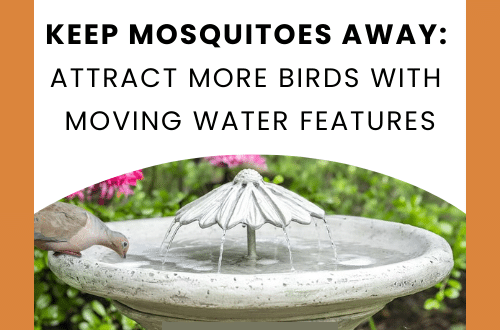-
The Ultimate Bird Feeder Bracket System
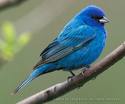 Usually only seeing one pair, today we spotted five male red-breasted grosbeaks and two females at the platform feeders. Hummingbirds and cat birds are back, several indigo buntings (the other bluebirds) are hanging around, and we managed a fleeting glimpse of a Baltimore oriole today too.
Usually only seeing one pair, today we spotted five male red-breasted grosbeaks and two females at the platform feeders. Hummingbirds and cat birds are back, several indigo buntings (the other bluebirds) are hanging around, and we managed a fleeting glimpse of a Baltimore oriole today too.With spring migrations upon us it’s an awesome time to catch some new visitors… vivid colors abound in the landscape if you happen to be feeding birds right now.
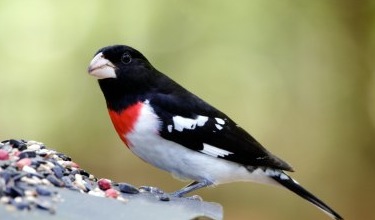 If you’re not- it’s a primo time to start!
If you’re not- it’s a primo time to start!Offering a variety of food like fruit and jelly and fresh water affords the opportunity for migratory birds to take up residence at your place and maybe even decide to nest there. This may require a few additional feeders, but you can be crafty here and fashion non-traditional items to use as feeders. A hanging glass candle holder makes a great jelly feeder, and there’s even an orange feeder for orioles made from a wire coat hanger. The “how to” is floating around the web somewhere! Fresh water works great in a simple plant saucer, and very shallow is always best for birds’ safety.
So even if you can
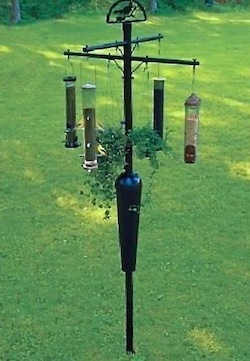 craft a few new feeders… you’ll need somewhere to hang them! It’s like all hands on deck… the more bird feeder brackets the better this time of year! Whether you’re a novice to backyard birding, or a long-time veteran, a good pole system just can’t be beat. If your battling pesky critters at feeders, the Squirrel Stopper comes with the most effective baffle around. From one of our customers: ‘We absolutely love the squirrel stopper so much so that my husband wanted another right away. It’s been comical around here watching the squirrels trying to win the battle of the baffle. LOL! and having to resort to what we put out for them elsewhere.”
craft a few new feeders… you’ll need somewhere to hang them! It’s like all hands on deck… the more bird feeder brackets the better this time of year! Whether you’re a novice to backyard birding, or a long-time veteran, a good pole system just can’t be beat. If your battling pesky critters at feeders, the Squirrel Stopper comes with the most effective baffle around. From one of our customers: ‘We absolutely love the squirrel stopper so much so that my husband wanted another right away. It’s been comical around here watching the squirrels trying to win the battle of the baffle. LOL! and having to resort to what we put out for them elsewhere.”It features four arms with eight sturdy hooks to hang any kind of feeder, even a birdbath too! Especially if your yard is small, you’ll be able to maximize with a variety of treats for feat
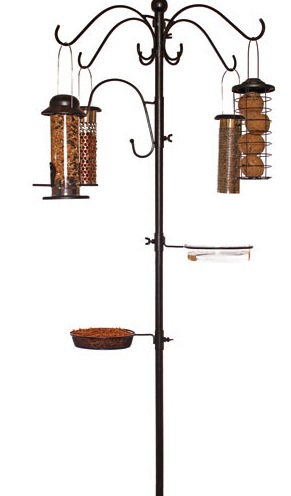 hered friends.
hered friends.If you’re new to the backyard birding scene, or know someone who is (hint: Mother’s Day), this complete bird feeder bracket system gets you up and running immediately! It comes with four basic feeders offering seed, peanuts, thistle and suet. That’s a fantastic mix to attract a wide variety of birds. The water dish promises to be a big hit, and the mesh tray is always open for options! Live or dried mealworms, fruit, even a cup of jelly for catbirds and orioles.
The only drawback is no baffle… we’d highly suggest using one to save your sanity and your bird food should squirrels abound in your yard!
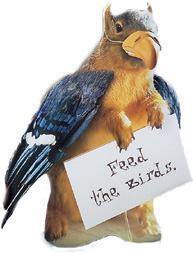
-
The Unintentional Bird Bath
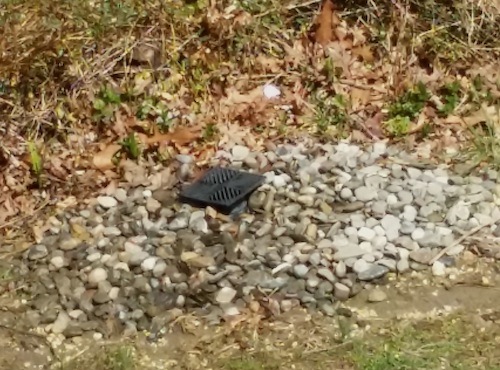 Last winter a water problem was discovered in the crawlspace. Ground water was coming up pretty high and slowly rotting out the support beams. First thought to be a lack of ventilation – but it turns out this had been a longstanding problem.
Last winter a water problem was discovered in the crawlspace. Ground water was coming up pretty high and slowly rotting out the support beams. First thought to be a lack of ventilation – but it turns out this had been a longstanding problem.Over the summer a sump pit was dug, a pump and float switch added, and drain hose was run outside, across the side yard. A simple outlet was created with gravel. It pumped all winter long, even during snowy weather, and is pumping right now. The water pools around the gravel and ultimately sinks into the ground.
Flocks of resident birds gathered there all winter, particularly during really cold weather. While this is near the bird feeders, there were many birds (like robins) who don’t typically use them. Every time the pump ran, birds would swoop down and take a dip, or drink, and otherwise frolic in the temporary pond. Leaning towards burying a bird bath or some kind of large shallow form near there for summer so the water will be able to pool longer.
This is clean, filtered ground water, it flows so it doesn’t freeze, and will be cooler in summer months. The best thing… it’s going to good use for the birds!
-
So What’s the Best Tube Bird Feeder for Spring?
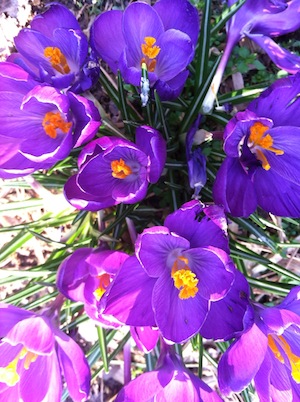 With spring in bloom (in much of the country anyway) there’s an instinct among nature types to get outdoors and work in the garden! For many, wild birds go hand-in-hand with love of gardening. Like the “eyes bigger than stomach” syndrome at a restaurant, heading into nurseries can easily turn into more than one bargained for! We know this first hand, as flowers sit in the driveway waiting to be planted.
With spring in bloom (in much of the country anyway) there’s an instinct among nature types to get outdoors and work in the garden! For many, wild birds go hand-in-hand with love of gardening. Like the “eyes bigger than stomach” syndrome at a restaurant, heading into nurseries can easily turn into more than one bargained for! We know this first hand, as flowers sit in the driveway waiting to be planted.Luckily for perennials like these crocus, color emerges effortlessly year after year. It also signals the beginning of nesting season for resident birds, and the migratory start for our southern feathered friends.
On the birding side, it’s a perfect time to give feeders a good cleaning, check birdhouses for old nests and clean them out too. Avoid leaving old nests on the ground near birdhouses as this attracts predators. Lots of fancy cleaners on the market, but a solution of bleach and water (1:10 ratio) is ideal. Scrub, rinse well, air dry… pretty simple.
If you’re just getting into the birding thing (lots of folks are these days) – where to start? So many feeders and gadgets out there! Fresh water and a
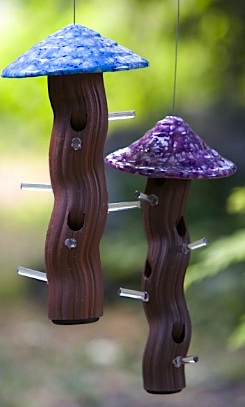 tube bird feeder are a great place to start! All birds are attracted to fresh water, be it a traditional birdbath, or simple pan of shallow water. Shallow’s the optimal word, 2-3-inches maximum is recommended. Something with texture too, as bird’s feet can get a better grip. Small rocks or pebbles in the bowl help with landing and perching.
tube bird feeder are a great place to start! All birds are attracted to fresh water, be it a traditional birdbath, or simple pan of shallow water. Shallow’s the optimal word, 2-3-inches maximum is recommended. Something with texture too, as bird’s feet can get a better grip. Small rocks or pebbles in the bowl help with landing and perching.So, what’s the best tube feeder? Like the bath, or anything else for that matter… it’s the one you will maintain! Feeders need to be filled fairly consistently, as well as cleaned. Wet, moldy seed serves no purpose at all, and birds will quit visiting a feeder with nasty contents. Plus it can spread disease among the local avian buddies in your yard.
Consider who you’d like to attract too. Thistle or nyjer seed is made for tube feeders, they have tiny ports for this tiny seed. Goldfinches, house and purple finches, siskins, buntings and redpolls enjoy thistle. Say you want a more “all-around” type feeder for chickadees, titmice, cardinals, nuthatches and some of the other usual suspects? You can’t beat a tube feeder with sunflower seed! It’s popular among many species and a great choice for a first or only feeder.
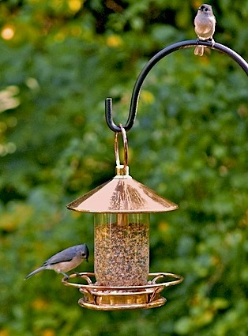 Some offer generous seed trays that make it easy for cardinals to feed. Although there are some general thoughts as to who will eat where, this winter proved all bets were off! Cardinals seen eating at suet feeders, juncos at sunflower feeders, and some other strange sightings due to the extreme weather.
Some offer generous seed trays that make it easy for cardinals to feed. Although there are some general thoughts as to who will eat where, this winter proved all bets were off! Cardinals seen eating at suet feeders, juncos at sunflower feeders, and some other strange sightings due to the extreme weather.The other really nice thing is that you can buy this seed sans the shell. Sunflower hearts (or meats) is a waste-free food that leaves hardly any ground mess. Whatever should fall to the ground is usually gobbled up by ground feeding birds like doves, juncos or chipping sparrows. It costs a few dollars more, but we think it’s well worth it! Cheaper seed leaves more waste because of the fillers most birds peck out and discard… so where’s the value?
In choosing a new tube bird feeder, pick one with sturdy construction that you know will last. Although inexpensive, plastic isn’t always the best choice as squirrels can and likely will chew it to bits. Ceramic is chew-proof, as is copper, stainless steel, and many of the newer materials used to hand craft or manufacture quality bird feeders.
Your birds will thank you!

